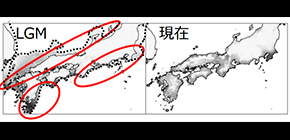
Where did broadleaved evergreen trees survive during the last glacial period in Japan?
New evidence for conservation of genetic diversity
Japanese researchers investigated whether a dominant tree of warm temperate broadleaved forests in Japan, Castanopsis sieboldii , underwent northward migration over hundreds of kilometres from Last Glacial Maximum (LGM) (about 21,000 years ago) refugia in the Ryukyu archipelago and southern Kyushu, where fossil pollen indicates the LGM survival of broadleaved evergreen forests, or was in fact able to survive closer to its present range in colder areas such as the coast of the Japan Sea and the Pacific Ocean side of eastern Honshu during the Last Glacial Maximum (LGM). Using a combined genetic analysis and modelling approach, it was found that the East Japan populations, where few pollen fossil records exist, survived in situ during the LGM on both the Japan Sea and Pacific coasts and were not established via expansion after the LGM from southern areas. Their findings were published online in Heredity .
The climate of the earth about 21,000 to 18,000 years ago during the LGM was particularly cold, with average temperatures 5 to 7 °C lower than the present-day. From the excavation of fossil pollen and plant bodies, it is believed that broadleaved evergreen forests were driven to warmer areas in the Ryukyu Archipelago and southern Kyushu during the LGM. After the LGM, they expanded their distribution northward to the Japan Sea and the Pacific coast. There has been a debate on whether the broadleaved evergreen forests, which presently occupy wide areas in warm temperate regions of Japan, had expanded from a limited area in the southern part of Kyushu, or survived in small forests in various areas in Japan. Using a species distribution modelling approach to model the species’ LGM distribution, a suitable climate is predicted in the southern part of the Pacific coast (Fig. 1), which is further supported by genetic evidence.
In the study, researchers investigated where C. sieboldii , a dominant tree species of broadleaved evergreen forests in Japan, inhabited during the glacial period by constructing multiple models based on genetic diversity. The result indicated that the Ryukyu and the West Group existed from the oldest period, and that the East and the Japan Sea Group were formed from the West Group (Figure 2). Furthermore, the estimated time of diversification suggested that these four groups had already been established before the LGM. The result suggested that C. sieboldii survived separately in Ryukyu, West, Japan Sea, East during the LGM, and expanded the population as it became warmer during the past-glacial.
This study identified major genetic lineages in the broadleaved evergreen tree species C. sieboldii in the Ryukyu Archipelago, Western Japan, the Japan Sea, and Eastern Japan. The unique genetic composition of each region has formed as a result of a long history of genetic isolation associated with the glacial-interglacial cycles.
In recent years, the importance of preserving local genetic diversity has been recognized. When planting broadleaved trees to assist natural regeneration or during afforestation, it is necessary not to disturb the local genetic diversity as much as possible.
Lead author Kyoko Aoki at Osaka University says, “Our research highlights the importance of restricting the distribution of seedlings across the genetic boundaries identified between Ryukyu, Western Japan, Japan Sea, and Eastern Japan in order to retain genetic patterns which have formed over thousands of years.”
***
This study was performed in collaboration with Forestry and Forest Products Research Institute, Osaka University, Gifu Academy of Forest Science and Culture, University of Tsukuba, Kyoto University, and Tokyo Metropolitan University.

Fig. 1: Species distribution modeling of C. sieboldii .
Area with darker color indicates higher probability of suitable habitat. In the Last Glacial Maximum (LGM), the sea level decreased by about 120 m compared to the present, and the land was expanded. The dashed line shows the estimated coastline at the LGM. The areas surrounded by a red line are estimated areas (West Japan, Japan Sea, and East Japan), where C. sieboldii is likely to have survived during LGM based on genetic and modelling based evidence (the Ryukyu archipelago is not shown in the figure).
(©2018 Forestry and Forest Products Research Institute, Osaka University, and Gifu Academy of Forest Science and Culture)

Fig. 2: The best historical demographic model of C. sieboldii .
In this model, after the Ryukyu (R) and the West (W) Group diverged, the Japan Sea (J) and the East (E) Group diverged from the West (W) Group. West and East Group includes populations in western and eastern parts of the main islands along the Pacific Coast, respectively. The branch length is proportional to the number of generations, with the major splits in the species estimated to have occurred 118,400 and 43,100 years ago, assuming that one generation of C. sieboldii is 100 years.
(©2018 Forestry and Forest Products Research Institute, Osaka University, and Gifu Academy of Forest Science and Culture)
The article, “Approximate Bayesian computation analysis of EST associated microsatellites indicates that the broadleaved evergreen tree Castanopsis sieboldii survived the Last Glacial Maximum in multiple refugia in Japan” was published in Heredity , https://doi.org/10.1038/s41437-018-0123-9 .
Related links


